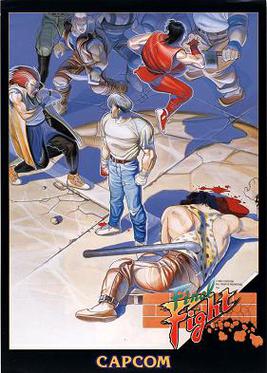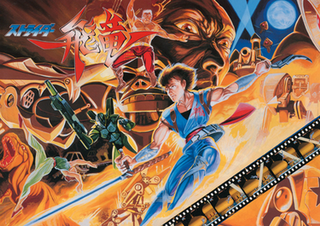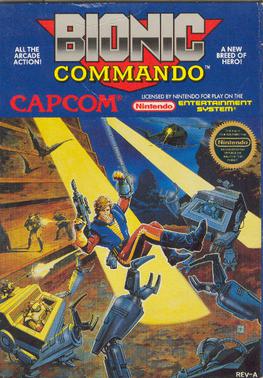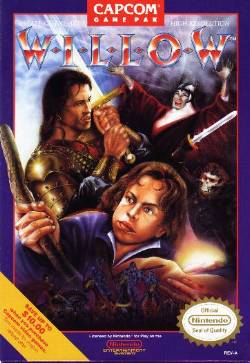
Final Fight is a side-scrolling beat-'em-up video game produced by Capcom. Originally released as an arcade game in 1989, it was the seventh title released for the CP System hardware. Set in the fictional Metro City, the game lets the player control one of three street fighters: former pro wrestler and city mayor Mike Haggar, expert brawler Cody Travers, and modern-day ninja Guy. The trio set out to rescue Jessica when she is kidnapped by the Mad Gear Gang.

1942 is a vertically scrolling shooter by Capcom that was released as an arcade video game in 1984. Designed by Yoshiki Okamoto, it was the first game in the 194X series, and was followed by 1943: The Battle of Midway.

Kung-Fu Master, known as Spartan X in Japan, is a side-scrolling beat 'em up game developed by Irem as an arcade game in 1984, and distributed by Data East in North America. Designed by Takashi Nishiyama, the game was based on Hong Kong martial arts films. It is a loose adaptation of the Jackie Chan, Sammo Hung, and Yuen Biao film Wheels on Meals (1984), called Spartan X in Japan, with the protagonist Thomas named after Jackie Chan's character in the film. The game is also heavily inspired by the Bruce Lee film Game of Death (1972), which was the basis for the game's concept. Nishiyama, who had previously designed the side-scrolling shooter Moon Patrol (1982), combined fighting elements with a shoot 'em up gameplay rhythm. Irem and Data East exported the game to the West without the Spartan X license.

Ghosts 'n Goblins, known as Makaimura in Japan, is a platform video game developed by Capcom and released for arcades in 1985. It is the first game in the Ghosts 'n Goblins franchise, and has since been ported to numerous home platforms.

Strider, released in Japan as Strider Hiryū, is a hack-and-slash platform game released in arcades in 1989 by Capcom. Set in a dystopian future where Earth is ruled by the tyrannical Grandmaster Meio, it follows the titular Strider named Hiryu as he attempts to end his tyrannical reign for good. The game resulted from cooperation between Capcom and manga publisher Moto Kikaku. It marked the video game debut of Strider Hiryu, after the character was introduced in the 1988 manga Strider Hiryu.

Strider 2, released in Japan as Strider Hiryū 2, and then as Strider Hiryū 1&2, is a platform video game. It is developer and publisher Capcom's 1999 sequel to the original Strider. This game is the second sequel to Strider produced, following U.S. Gold's 1990 noncanonical Strider II, a game with which Capcom was not directly involved. The Capcom-produced Strider 2 makes no references to the Western-only Strider Returns/Strider II. The game was released for arcades in 1999 and was ported to the PlayStation in 2000.

Rush'n Attack, also known as Green Beret in Japan and Europe, is a run-and-gun and hack-and-slash video game developed and released by Konami for arcades in 1985, and later converted to the Nintendo Entertainment System and home computers. Its North American title is a play on the phrase "Russian attack" due to its Cold War setting. It was ported to home systems and became a critical and commercial success for arcades and home computers.
1988 saw many sequels and prequels in video games, such as Dragon Quest III, Super Contra, Super Mario Bros. 2, Mega Man 2, Double Dragon II: The Revenge, and Super Mario Bros. 3, along with new titles such as Assault, Altered Beast, Capcom Bowling, Ninja Gaiden, RoboCop, Winning Run and Chase H.Q.

Bionic Commando is a video game franchise consisting of an original arcade video game released in 1987 and several later versions and sequels. The games are platform games in which, with two exceptions, the player cannot jump. A bionic arm is used to cross gaps and climb ledges. The player character, Nathan "Rad" Spencer, uses this as a grappling gun/hook to swing, climb and descend through levels. Seven games have been released, from the original 1987 Bionic Commando to 2011's Bionic Commando Rearmed 2. The series is based in an alternate timeline in which Nazism is not completely eradicated following World War II.

U.N. Squadron is a 1989 side-scrolling shooting game released by Capcom for the CPS arcade hardware and for the Super Nintendo Entertainment System. The game was released in Japan as Area 88, and is based on the manga series of the same name, featuring the same main characters. Their mission is to stop a terrorist group known as Project 4. It was followed by a spiritual successor Carrier Air Wing.

Street Fighter II Turbo: Hyper Fighting is a competitive fighting game released by Capcom for arcades in 1992. It is the third arcade version of Street Fighter II, part of the Street Fighter franchise, following Street Fighter II: Champion Edition, and was initially released as an enhancement kit for that game. Released less than a year after the previous installment, Turbo introduced a faster playing speed and new special moves for certain characters, as well as further refinement to the character balance.
Hiroshi Motomiya is a Japanese manga artist from Chiba Prefecture. His works include Tenchi wo Kurau (1983–1984) and Salary Man Kintaro (1994–2002).

Bionic Commando, originally released as Hitler's Resurrection: Top Secret in Japan, is a platform game released by Capcom for the Family Computer and Nintendo Entertainment System in 1988. It is based on the 1987 arcade game Bionic Commando.

The Nintendo Entertainment System (NES) is an 8-bit third-generation home video game console produced by Nintendo. It was first released in Japan in 1983 as the Family Computer (FC), commonly referred to as Famicom. It was redesigned to become the NES, which was released in American test markets on October 18, 1985, and was soon fully launched in North America and other regions.

Ghosts 'n Goblins, known in Japan as Makaimura, is a run-and-gun platform video game series created by Tokuro Fujiwara and developed by Capcom. The first entry in the series was Ghosts 'n Goblins, released in arcades on July 7, 1985. The series has subsequently been ported to and released on a variety of personal computers, game consoles and mobile platforms and spawned several sequels and spin-offs.

Strider, known in Japan as Strider Hiryū, is a platform-adventure hack and slash video game developed by Double Helix Games and Capcom's Osaka studio. It was released in February 2014 for PlayStation 3, PlayStation 4, Windows, Xbox 360, and Xbox One. It is a reboot of the 1989 video game Strider.

Captain Commando is a 1991 futuristic side-scrolling beat 'em up originally developed and published by Capcom as an arcade video game, and later ported to several other platforms. It was the seventeenth game produced for the company's CP System hardware. The game stars the titular superhero who was originally conceived as a fictional spokesman used by Capcom USA in the company's console games during the late 1980s. On September 13, 2018, Capcom announced Capcom Beat 'Em Up Bundle with Captain Commando being one of seven titles and released digitally for Nintendo Switch, PlayStation 4, Xbox One, and Windows on September 18, 2018.

Willow is a 1989 2D action role-playing game developed and published by Capcom for the Nintendo Entertainment System. It is loosely based on the 1988 film of the same name and is the second title Capcom released based on Willow that year, the first being an unrelated side scrolling arcade game. The version of Willow released for the Nintendo Entertainment System and the Famicom is an adventure game in the vein of The Legend of Zelda.
















